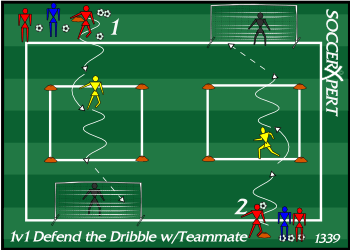1v1 Defending the Dribble with Teammate
The purpose of this drill is to isolate the defender to focus on the first defender and defending the dribble while working with a teammate. This teaches young soccer players to work together with your teammate to shut down the attacker.
The purpose of this drill is to isolate the defender to focus on the first defender and defending the dribble while working with a teammate.
Drill setup- Create a grid that is 50 yards wide by 40 yards deep.
- Place a goal about 10 yards from the sideline on two of the diagonal corners.
- Place a goalkeeper in each of the goals.
- 15 yards from each goal, create a 10 X 10 grid, and set a cone on the opposite end lines as a starting point for the players. See diagram for field layout.
- Split the team into groups of 2, each partner group having the same jersey color.
- One of the teammates starts in line 1 where the other player begins in line 2 in the same order, so they go simultaneously.
- Begin with one set of partners as the defenders, each in one of the two 10X10 grids in front of the goal.
- The attackers (partners) from line 1 and line 2 go simultaneously on the coach's command.
- The attackers attempt to dribble through the grid directly in front of them and shoot on goal.
- If the attacking player successfully makes it through the grid and out the other side by dribbling, the attacker attempts to score a goal.
- The defenders try to deny the player from dribbling through the grid.
- If both of the defenders wins the ball, or the ball is knocked out the sides of the grid, do the attacking team become the defenders.
- If only one defender wins the ball and the other team makes it through the grid, the defenders stay and continue to defend the grid with the next group of partners.
- This drill's pace must be fast-paced and encourage players to take advantage of an off-balanced defender.
- The defender will have to transition quickly to get out of the middle.
- Have the attackers become defenders if neither of the two scores a goal. This will create a lot of defender changes and will allow you to work on the transition.
When defending 1v1's in soccer, it is essential to focus on the following key elements:
- Staggered stance with toes at a 45-degree angle.
- Bent knees with weight on the balls of the feet.
- Chest leaning over the toes.
- Low center of gravity for greater explosion/quick change of direction (upright takes longer to start).
- Ability to shuffle quickly.
- Pay attention to the distance of pressure (depends on the speed of attacker vs. the speed of the defender), usually 1-3 yards
Remember that the player closest to the attacker should be the player pressuring the ball. Players should sprint to close down space as quickly as they can, then when they get 5 yards from the attacker, they should slow down and take steps backward to match the attacker's pace. During this time, the defender should slowly close down the space between the attacker and defender. Often proper pressure will cause the attacker to lose the ball.
One way to have players recall the proper way to defend is by "Quick, Slow, Sideways, Low."
Quick refers to the defender's speed while closing down the attacker with the ball. This should be done at full speed sprint, and note that it is often best to close down the ball when the ball is in flight.
Slow refers to the defenders' ability to change speed and direction required to start moving in the same direction as the attacker.
Sideways refers to the body positioning often used when defending. The defender should turn their body at a 45-degree angle to create the largest amount of defensive area.
Low refers to the body positioning with the knees bent and the center of gravity low to the ground.
- 1V1 DEFENDING
- 1ST DEFENDER
- DEFENDING THE DRIBBLE
